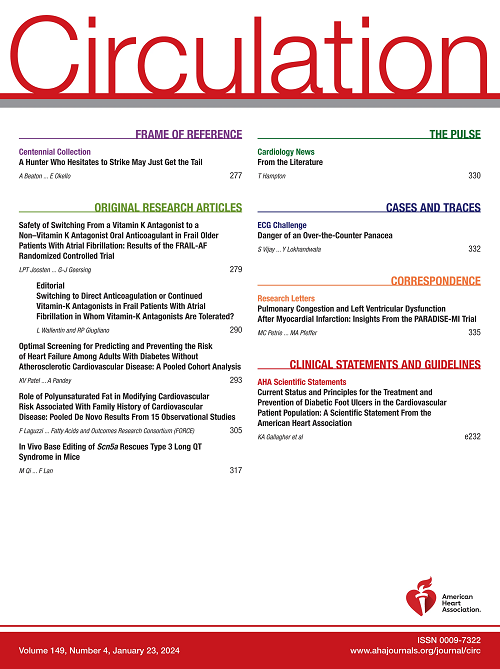Bailout Intracranial Angioplasty or Stenting After Thrombectomy for Acute Large Vessel Occlusion: 1-Year Outcomes of ANGEL-REBOOT.
IF 38.6
1区 医学
Q1 CARDIAC & CARDIOVASCULAR SYSTEMS
引用次数: 0
Abstract
BACKGROUND The long-term benefits of bailout intracranial angioplasty or stenting (BAOS) after thrombectomy in patients with acute large vessel occlusion remain unclear. This study compared BAOS with standard therapy in patients with large vessel occlusion with unsuccessful recanalization (expanded Thrombolysis In Cerebral Infarction score 0-2a) or >70% residual stenosis after thrombectomy. METHODS ANGEL-REBOOT (Randomized Study of Bailout Intracranial Angioplasty Following Thrombectomy for Acute Large Vessel Occlusion) was a multicenter, open-label, blinded-end point, randomized trial conducted across 36 Chinese hospitals. Patients ≥18 years of age with anterior or posterior circulation large vessel occlusion within 24 hours of stroke onset were enrolled. After identification of thrombectomy failure or high-grade residual stenosis, patients were randomly assigned to the BAOS group (intervention) or the standard therapy group (control), in which thrombectomy was continued or terminated. The use of tirofiban was permitted in both groups during and after the procedure. In the intention-to-treat population, the primary outcome was analyzed using an assumption-free ordinal analysis (Wilcoxon-Mann-Whitney test) to compare the modified Rankin Scale scores (ordinal variable ranging from 0 to 6) between groups at 1-year follow-up, from which the generalized odds ratio was derived. Secondary outcomes included stroke recurrence in the treated artery and all-cause mortality within 1 year, analyzed using Cox proportional hazards models. RESULTS A total of 348 patients were randomly assigned (176 to the BAOS group and 172 to the standard therapy group) and followed for 90 days, from December 19, 2021, to June 2, 2023. Of these, 326 patients (166 in the BAOS group and 160 in the standard therapy group) completed the 1-year follow-up. Compared with standard therapy, BAOS significantly improved the 1-year modified Rankin Scale score distribution (generalized odds ratio, 1.34 [95% CI, 1.05-1.73]; P=0.02). Fewer stroke recurrences in the treated artery occurred in the BAOS group than in the standard therapy group (7 of 166 [4%] versus 21 of 160 [13%]; hazard ratio, 0.30 [95% CI, 0.13-0.71]; P=0.006). One-year mortality rates were similar between groups (25 of 166 [15%] versus 27 of 160 [17%]; hazard ratio, 0.87 [95% CI, 0.50-1.50]). CONCLUSIONS Among Chinese patients with large vessel occlusion with unsuccessful recanalization or high-grade residual stenosis after thrombectomy, BAOS was associated with reduced disability and stroke recurrence after 1 year compared with standard therapy. REGISTRATION URL: https://www.clinicaltrials.gov; Unique identifier: NCT05122286.急性大血管闭塞取栓后紧急颅内血管成形术或支架植入术:ANGEL-REBOOT的1年结果。
急性大血管闭塞患者取栓后紧急颅内血管成形术或支架置入术(BAOS)的长期益处尚不清楚。本研究比较了BAOS与标准治疗在大血管闭塞再通不成功(脑梗死扩大溶栓评分0-2a)或取栓后残余狭窄bbb70 %患者中的应用。方法angel - reboot(急性大血管闭塞血栓切除术后紧急颅内血管成形术的随机研究)是一项多中心、开放标签、盲终点、随机试验,在中国36家医院进行。入组患者年龄≥18岁,卒中发作24小时内前后循环大血管闭塞。在确定取栓失败或高度残留狭窄后,将患者随机分为BAOS组(干预组)和标准治疗组(对照组),继续取栓或终止取栓。两组患者在手术期间和手术后均允许使用替罗非班。在意向治疗人群中,采用无假设序数分析(Wilcoxon-Mann-Whitney检验)对主要结局进行分析,比较各组随访1年的修正Rankin量表评分(序数变量范围从0到6),并由此得出广义优势比。次要结局包括治疗动脉卒中复发和1年内全因死亡率,使用Cox比例风险模型进行分析。结果随机抽取348例患者(BAOS组176例,标准治疗组172例),从2021年12月19日至2023年6月2日随访90天。其中,326例患者(BAOS组166例,标准治疗组160例)完成了1年的随访。与标准治疗相比,BAOS显著改善了1年修正Rankin量表评分分布(广义优势比1.34 [95% CI, 1.05-1.73]; P=0.02)。BAOS组治疗动脉卒中复发率低于标准治疗组(166例中有7例[4%],160例中有21例[13%];风险比为0.30 [95% CI, 0.13-0.71]; P=0.006)。两组一年死亡率相似(166例中有25例[15%],160例中有27例[17%];风险比为0.87 [95% CI, 0.50-1.50])。结论:在中国大血管闭塞且血栓切除后再通不成功或高度残留狭窄的患者中,与标准治疗相比,BAOS可降低1年后残疾和卒中复发。REGISTRATIONURL: https://www.clinicaltrials.gov;唯一标识符:NCT05122286。
本文章由计算机程序翻译,如有差异,请以英文原文为准。
求助全文
约1分钟内获得全文
求助全文
来源期刊

Circulation
医学-外周血管病
CiteScore
45.70
自引率
2.10%
发文量
1473
审稿时长
2 months
期刊介绍:
Circulation is a platform that publishes a diverse range of content related to cardiovascular health and disease. This includes original research manuscripts, review articles, and other contributions spanning observational studies, clinical trials, epidemiology, health services, outcomes studies, and advancements in basic and translational research. The journal serves as a vital resource for professionals and researchers in the field of cardiovascular health, providing a comprehensive platform for disseminating knowledge and fostering advancements in the understanding and management of cardiovascular issues.
 求助内容:
求助内容: 应助结果提醒方式:
应助结果提醒方式:


